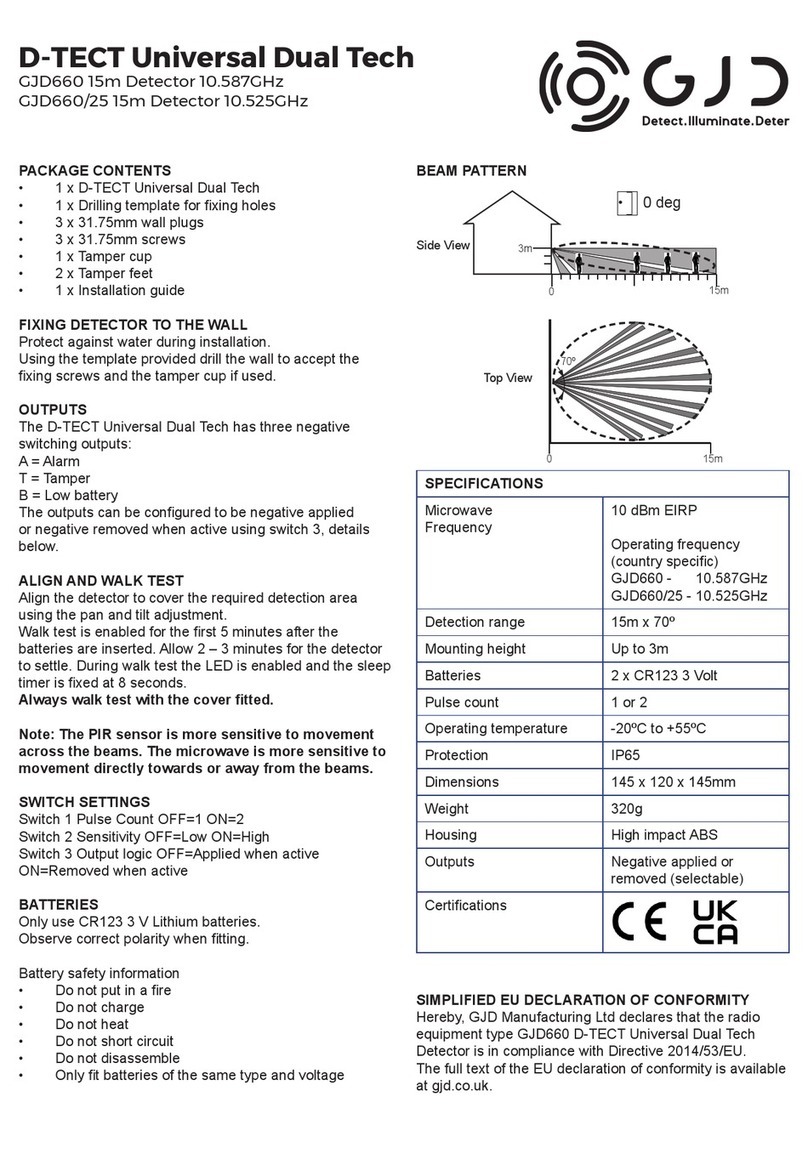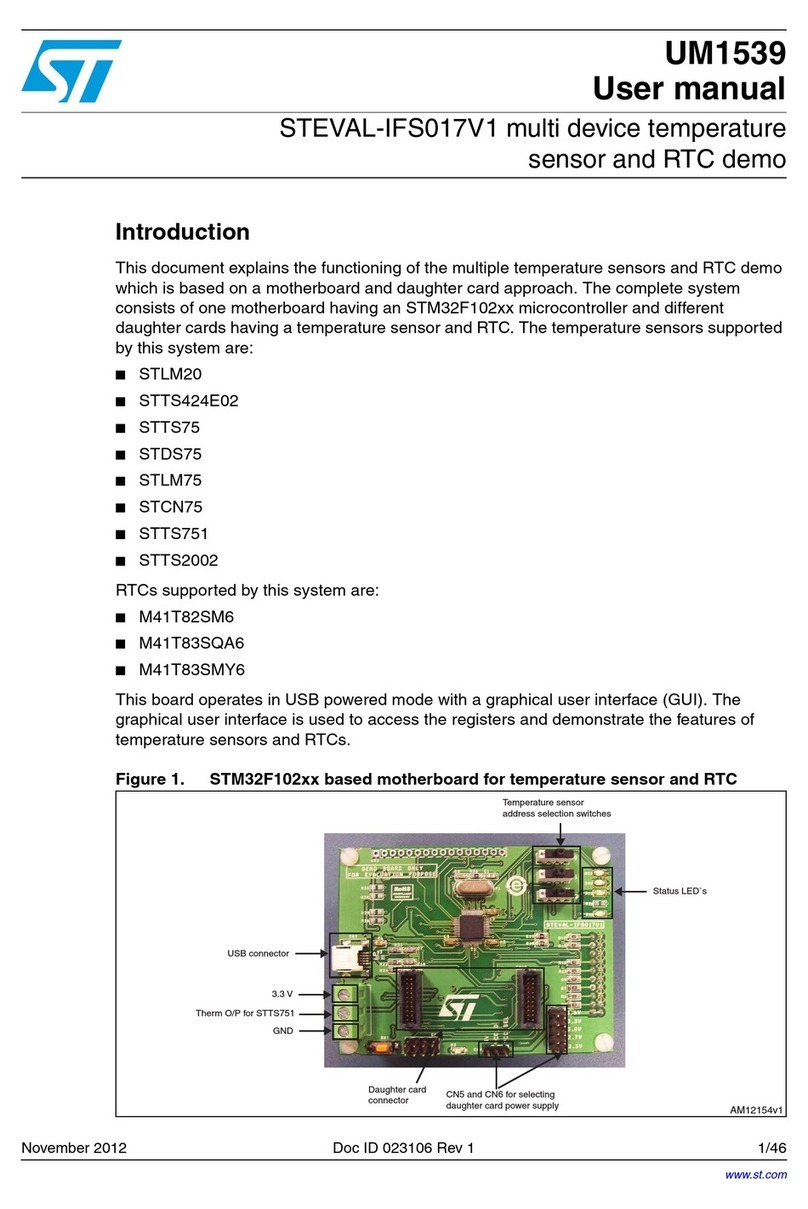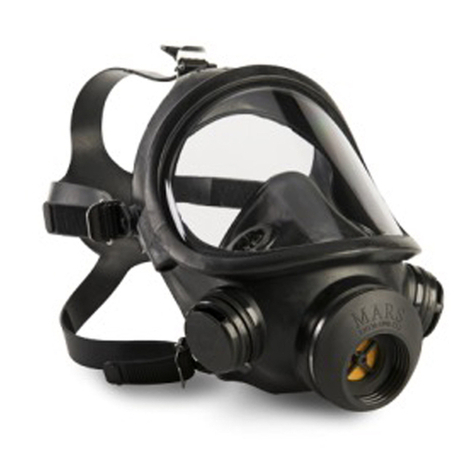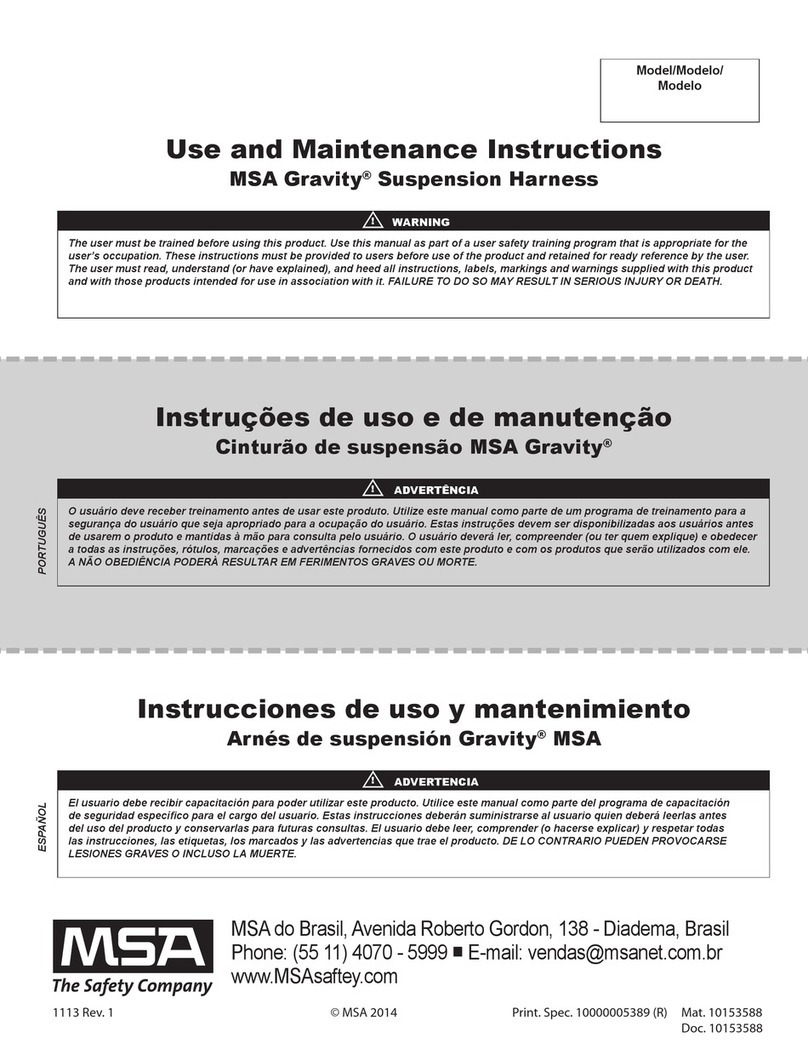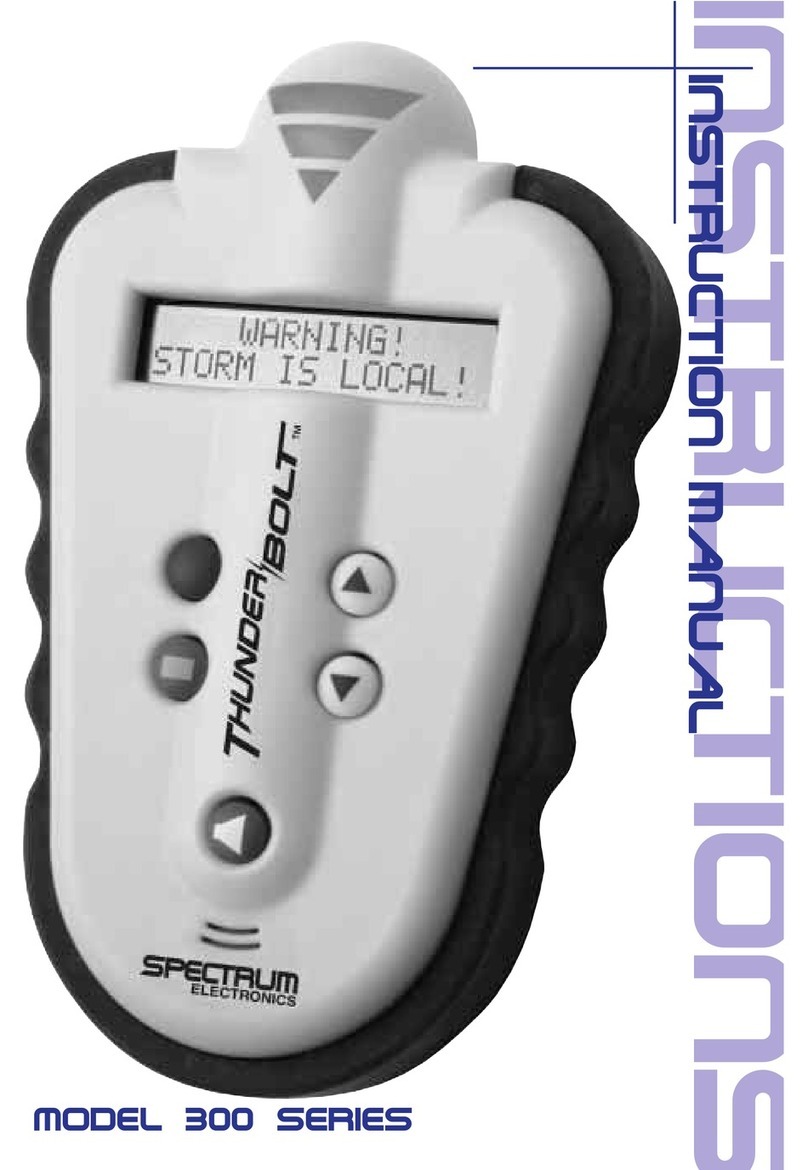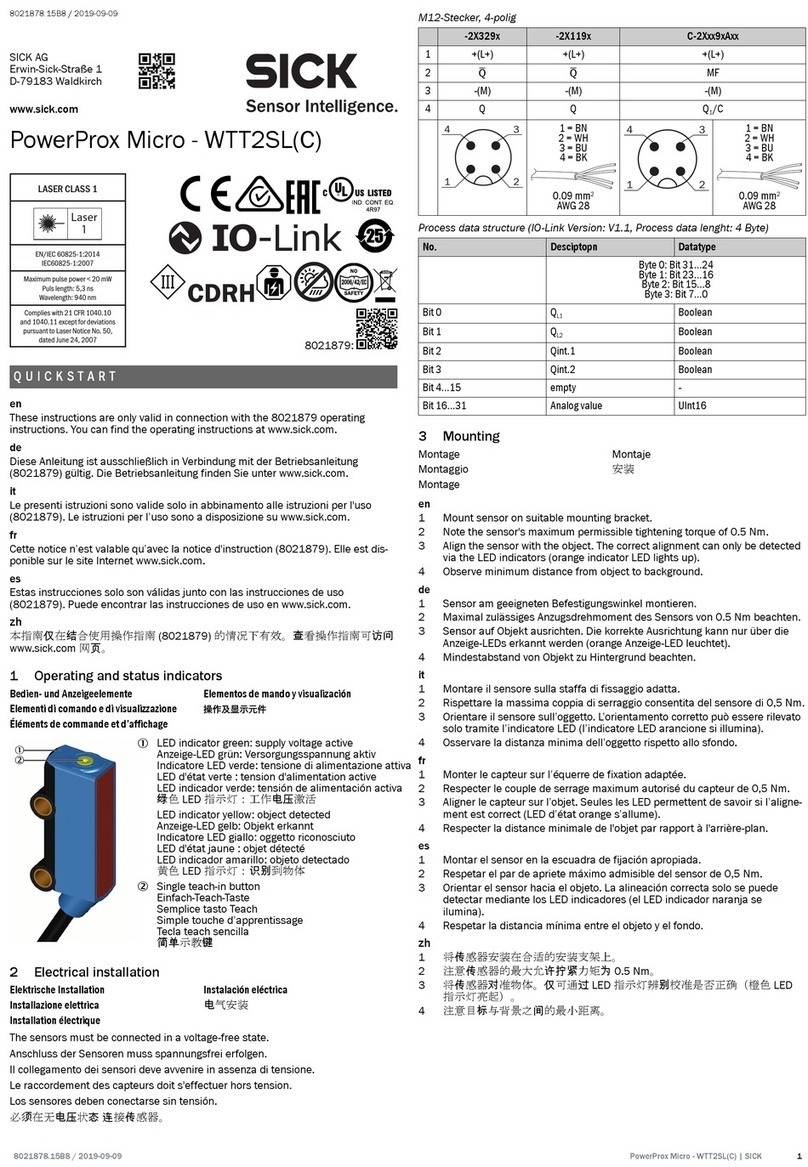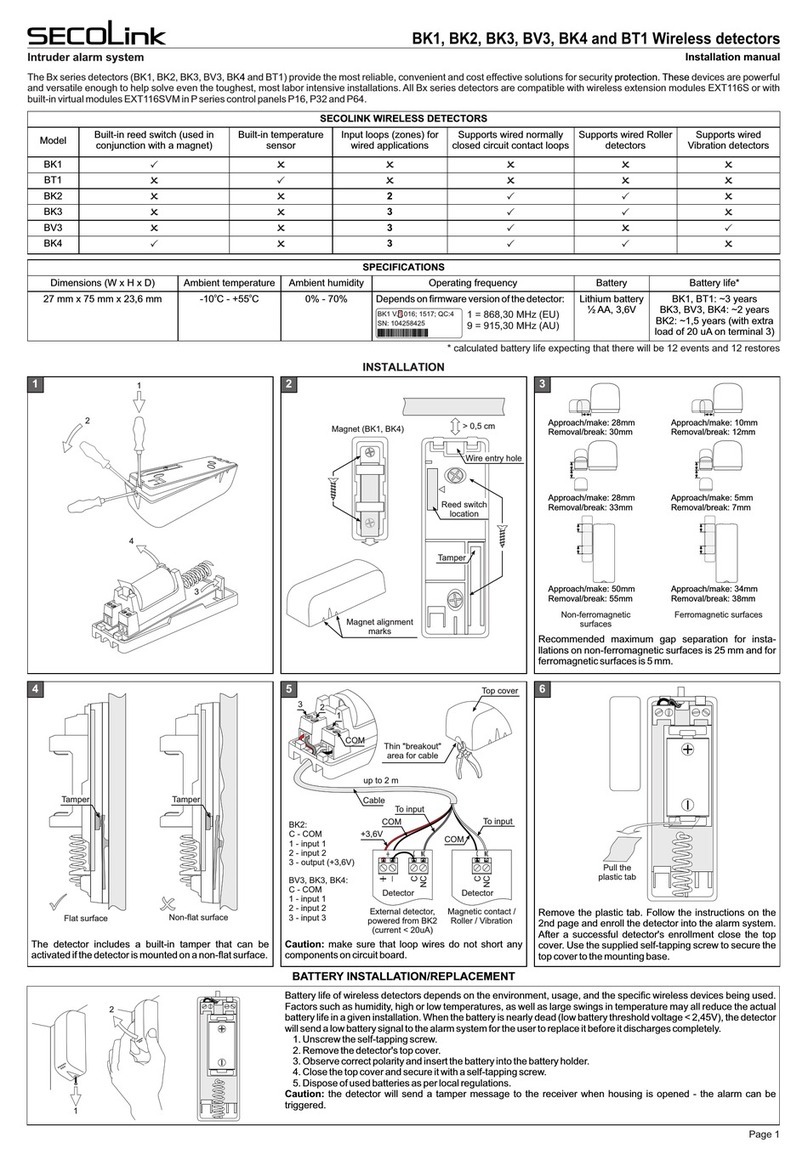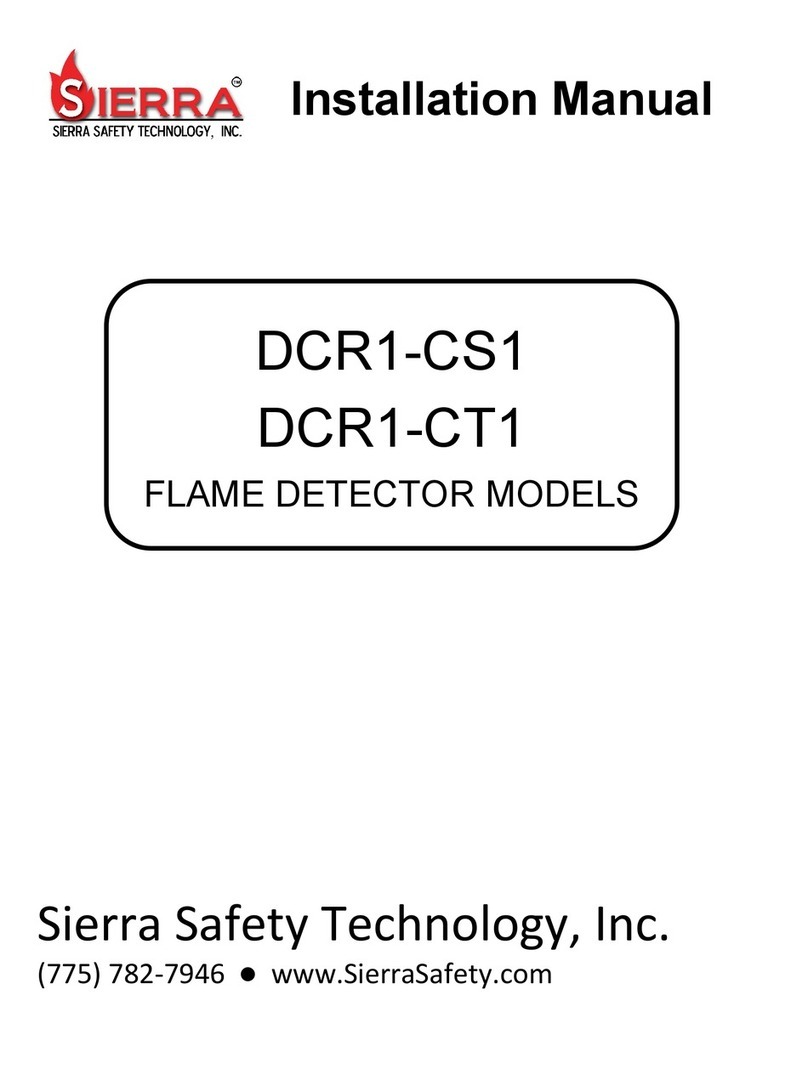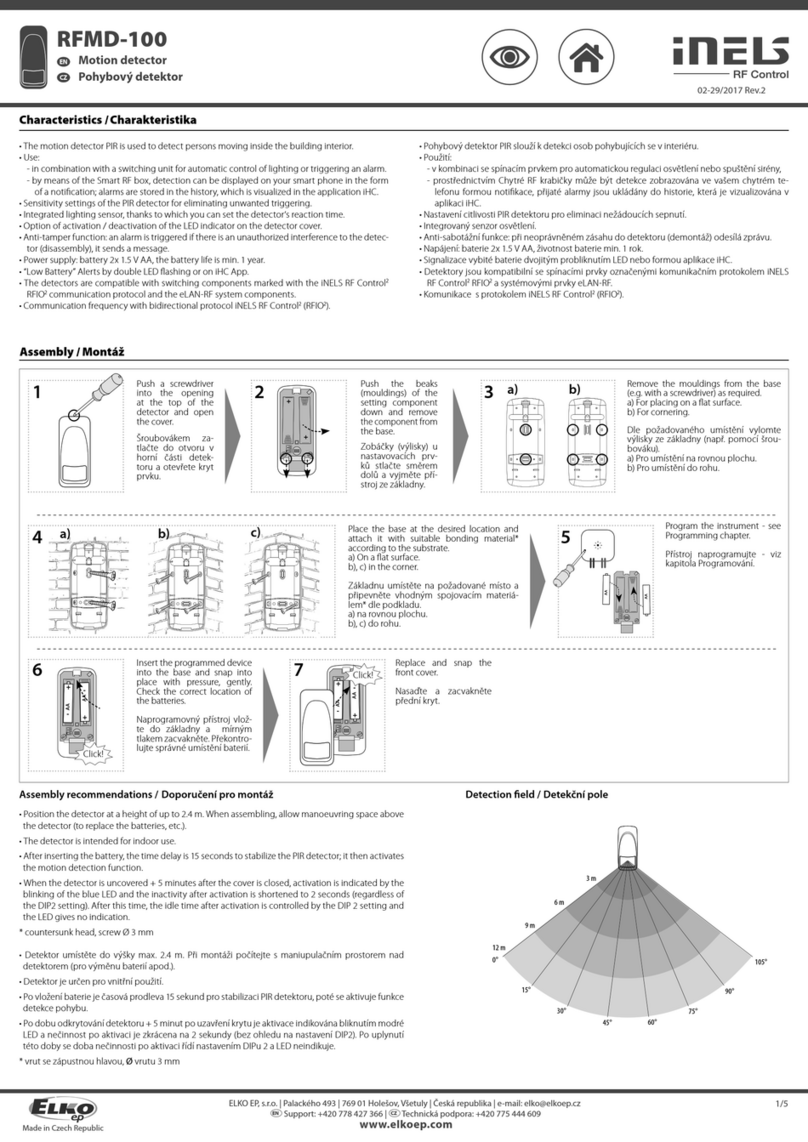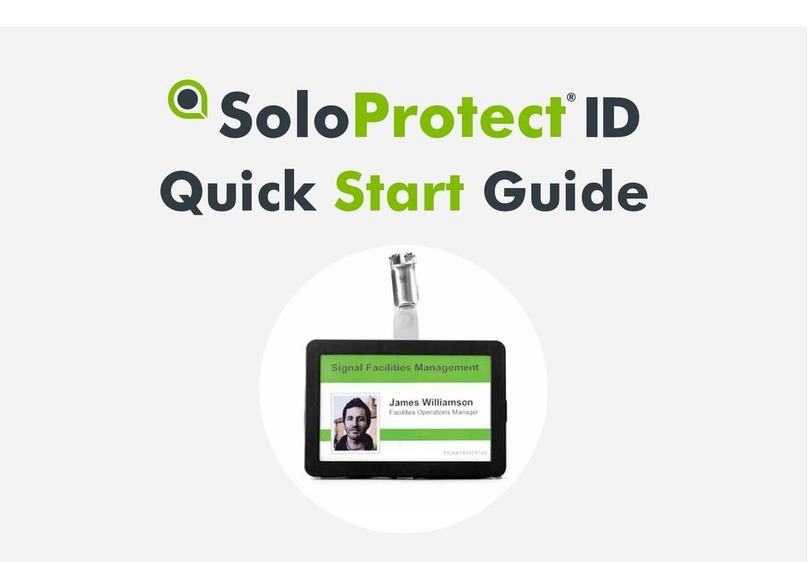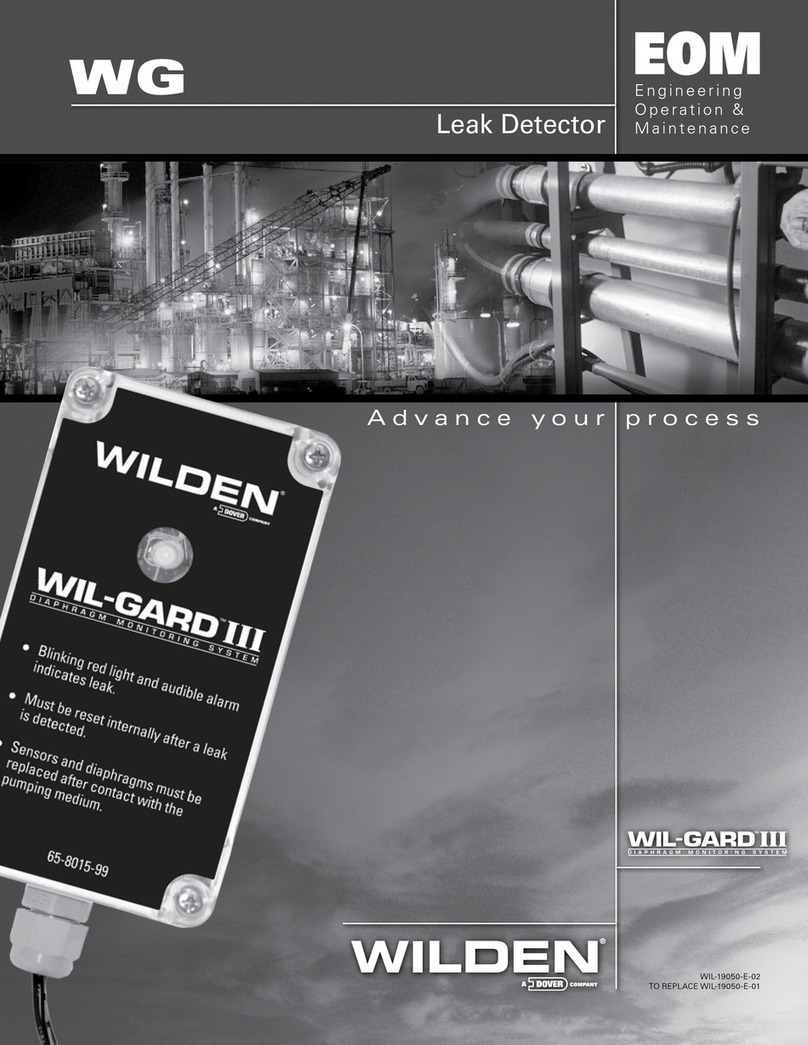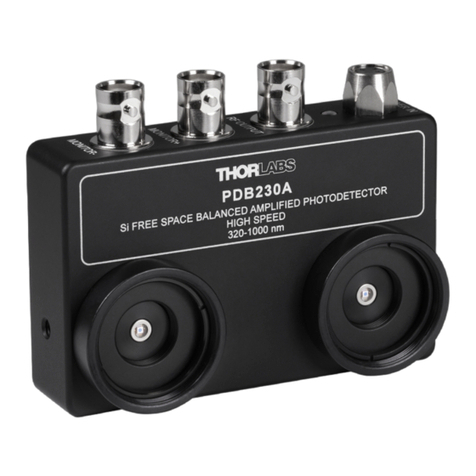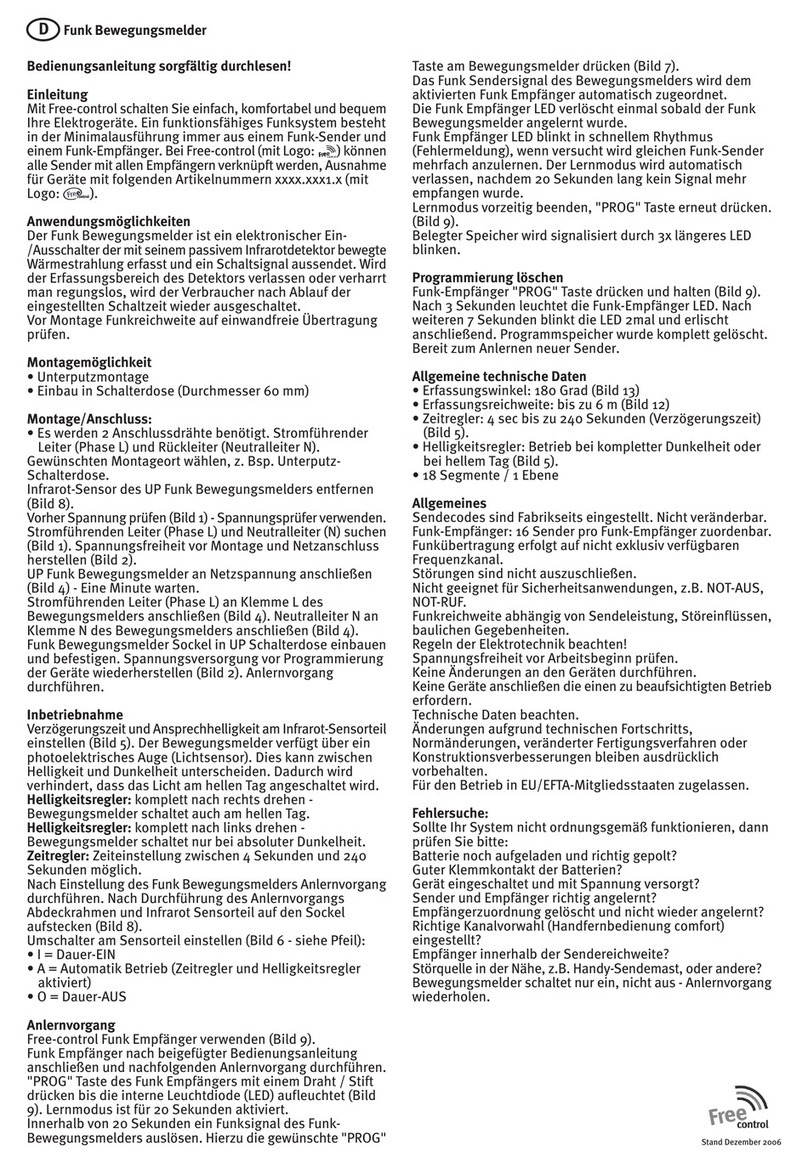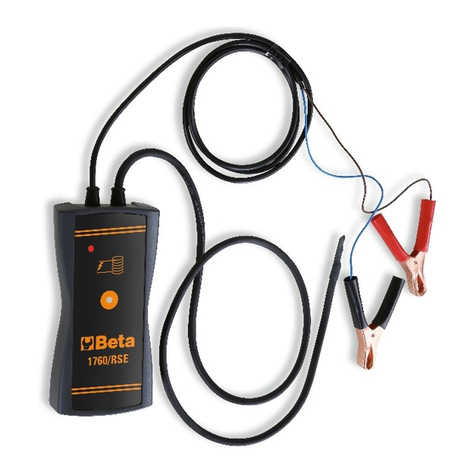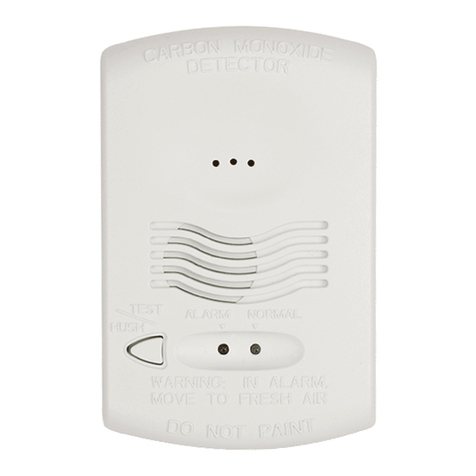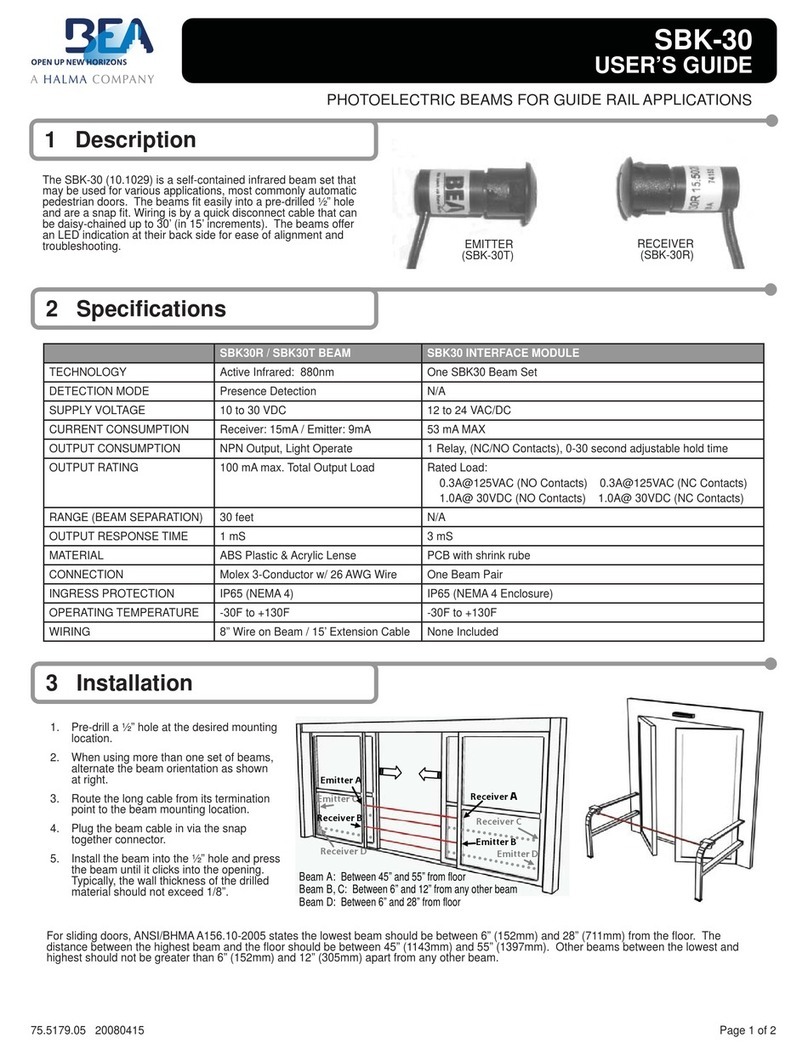EDWARDS SYSTEMS TECHNOLOGY IRC-3 Owner's manual

IRC-3
Programming Manual
P/N 250060
Revised 14JUL97
firealarmresources.com

DEVELOPED BY Edwards Systems Technology
6411 Parkland Drive
Sarasota, FL 34243
(941) 739-4300
COPYRIGHT NOTICE Copyright © 1997 Edwards Systems Technology, Inc.
This manual and the products it describes are copyrighted by
Edwards Systems Technology, Inc. (EST). You may not reproduce,
translate, transcribe, or transmit any part of this manual without
express, written permission from EST.
This manual contains proprietary information intended for distribution
to authorized persons or companies for the sole purpose of
conducting business with Edwards Systems Technology, Inc. If you
distribute any information contained in this manual to unauthorized
persons, you have violated all distributor agreements and we may
take legal action.
CREDITS This manual was designed and written by the EST Technical
Services - Documentation Department, Sarasota.
firealarmresources.com

Programming Manual i
Content
Chapter 1 How To Begin 1.2
PC Hardware Requirements 1.3
Installing IRC-3 Data Entry Program 1.4
Dual Floppy Disk Systems 1.4
Hard Drive Systems 1.4
Program Filenames 1.6
System Program Files 1.6
Files Created During Data Entry 1.6
Program/System Limits 1.7
CM1(N) Memory Calculation 1.8
CM2N(D) Memory Calculation 1.9
System Addressing 1.11
Input and Output Addressing 1.14
RASP Addressing 1.18
SAN Module Addressing 1.18
Pseudo Points 1.20
ACP and FCCA Address Points 1.22
Output Priorities1.26
Programming Notes 1.32
CCS-1 Programming 1.32
CM2ND Programming 1.33
Glossary 1.35
Chapter 2 Starting The Program 2.2
Data Entry 2.5
Defining Field Panels 2.5
Panel Definition 2.6
Remote Annunciator Panel Definition 2.6
Audio Panel Definition 2.7
IRC-1 Panel Definition 2.8
Assigning Panel Configurations 2.8
Defining RZB Panels 2.16
Defining Devices/Zones 2.20
Defining Devices/Zone Responses 2.29
Defining Actions 2.38
Defining Time Controls 2.42
Defining Sequences 2.46
Defining "AND" Functions 2.49
Polling Address Menu 2.51
firealarmresources.com

ii Programming Manual
Program Listing 2.53
Data Transfer 2.57
Save New File 2.58
Retrieve File 2.59
File Directory 2.59
Creating Transmit Files 2.60
Transmitting Data to the Network 2.61
DOS Shell 2.68
Chapter 3 Enables and Disables 3.2
Typical Disable Applications 3.2
“AND” Function Programming 3.4
Actions 3.5
Sequences 3.9
Regenerative Network Programming 3.10
External Database Expander 3.19
Daylight Savings Time 3.21
Password Changing 3.22
Status Zone Action 9010 3.23
ZRM Programming 3.24
IRC-3 Data Entry Program 3.24
IRC-3 Data Entry Program Rev - 2.6 3.27
Workheets
firealarmresources.com

Programming Manual iii
Important information
Limitation of liability
The content of this manual is proprietary in nature and is intended
solely for distribution to authorized persons, companies, distributors
and/or others for the sole purpose of conducting business associated
with Edwards Systems Technology, Inc. The distribution of information
contained within this manual to unauthorized persons shall constitute a
violation of any distributor agreements and may result in
implementation of legal proceedings.
This product has been designed to meet the requirements of NFPA
Standard 72, 1996 Edition; Underwriters Laboratories, Inc., Standard
864, 7th Edition; and Underwriters Laboratories of Canada, Inc.,
Standard ULC S527. Installation in accordance with this manual,
applicable codes, and the instructions of the Authority Having
Jurisdiction is mandatory. EST, Inc. shall not under any circumstances
be liable for any incidental or consequential damages arising from loss
of property or other damages or losses owing to the failure of EST, Inc.
products beyond the cost of repair or replacement of any defective
products. EST, Inc. reserves the right to make product improvements
and change product specifications at any time.
While every precaution has been taken during the preparation of this
manual to ensure the accuracy of its contents, EST assumes no
responsibility for errors or omissions.
FCC warning
This equipment can generate and radiate radio frequency energy. If this
equipment is not installed in accordance with this manual, it may cause
interference to radio communications. This equipment has been tested
and found to comply within the limits for Class A computing devices
pursuant to Subpart B of Part 15 of the FCC Rules. These rules are
designed to provide reasonable protection against such interference
when this equipment is operated in a commercial environment.
Operation of this equipment is likely to cause interference, in which
case the user at his own expense, is required to take whatever measures
may be required to correct the interference.
firealarmresources.com

iv Programming Manual
Document history
IRC-3 Programming Manual P/N 250060
Revision Status
Revision
Program Manual Date Reason for Change
1.1 1-31-89 Initial release - UL listed.
1.4 A 6-1-89 Added: Coder programming.
2.0 B 10-16-89 Added: RZB12-6, verification on standard zones and M500MF, M501MF
modules, test actions, DOS shell.
2.1 C 2-26-90 Added: Actions 9011 thru 9020 for 1st thru 10th zone/device in alarm;
Data line baud rate setting; Job name identifier for sensitivity reports;
System communications class type; modem call back feature (not yet
supported in CM1N firmware).
2.3 D 10-1-90 (Pre-release for CM1N/2N firmware Rev. 1.3) Added: Adjustment for
daylight savings time; 600 event history file in RAM; External command
port; USA/European mode select; Remote downloading to CM2N from
CM1N; Watchdog reset counter in history; Enhanced coder support;
Variable system reset time based on configuration size; Trouble buzzer
disable when status zones are defined (action 9010); Expanded
maximum # of defined panels to 56 (52 Remote) with CM1NX or RMDP-
1NX; Dry contact option for RZB12-6 circuit IN/OUT 3 and IN/OUT 4.
2.4 E 2-15-91 (CM1N/CM2N firmware Rev. 2.0) CM2N regenerative network (Action
9006,9021-9052,9061-9092);VDU-3 support by CM2N; Variable baud
rate for panel-to-panel communication; Sensitivity/alternate sensitivity
selection by time/keypad; External database expander CM2N (addr.=
62); Automatic SANCOM function as main control point.
2.4 E.1 4-1-91 (CM1N/CM2N firmware Rev. 2.1) Sensitivity/alternate sensitivity
selection by time/keypad; Sensor maintenance alert notification (action
9008).
2.5 F 11-6-91 "A"/"B" series BRK device support; Reset/alarm silence Inhibit;
Broadcast bell-code; Update RS-232 communications protocol.
2.6 G 9-8-92 Replace all "FAST" references with "EST"; Correct alternate sensitivity
problem; Remove unused CM1N and CM2N menu items; Correct
RZB12-6 I/O 1-4 supervisory zone problem.
2.6 H 5-13-93 (CM1(N)(NX)/CM2(N)(D) firmware Rev. 3.0) Improved ZAS response
time; Added action 9009; Upgraded external command port protocol;
Improved alarm silence & reset inhibit timer operation; Revised
Canadian and European operating modes; Added CM2ND
programming information; Updated VDU-3 information.
4.0 1.0 02-15-95 Converted manual from WordPerfect to MS-Word format;
Reformatted text; Added screens for ZAS-2 configuration; Added
ZAS-2 worksheets; Updated other worksheets.
4.0 2.0 05-24-95 Added regenerative programming section.
4.0 3.0 06-20-95 Added ZRM programming, ZB8-5/3.
5.0 3.5 07-97 Layout and content changes.
firealarmresources.com

Programming Manual 1.1
Chapter 1
General Information
Content
How to Begin 1.2
PC Hardware Requirements 1.3
Installing Data Entry Program
1.4
Program Filenames 1.6
Program/System Limits 1.7
System Addressing 1.11
Programming Notes 1.32
Glossary 1.35
IRC-3
EDWARDS SYSTEMS TECHNOLOGY
TM
firealarmresources.com

1.2 Programming Manual
How To Begin
Without a careful and well planned approach to programming, the task
of data entry will become unmanageable. The IRC-3 network is very
versatile and capable of performing the same function in many different
ways. Because of the versatility of this program, a high degree of
system understanding and preparation is required to program the
system.
Note: If you have not filled out the program setup worksheets provided
in appendix A of this manual, you are NOT ready to begin the process
of data entry. COMPLETE THE WORKSHEETS FIRST!
The following steps must be completed in the order specified to ensure
a successful program:
1. Complete a system matrix sheet. A matrix sheet indicates the outputs
or functions performed as a result of an input change of state.
2. Complete the cabinet worksheets.
3. Complete the CM1(N) panel worksheet.
4. Complete the CM2(N) panel worksheets.
5. Complete the zone/option card worksheets.
6. Complete the RZB12-6 worksheets.
7. Complete the matrix or SAN annunciator worksheets.
8. Complete the program worksheets in the following order:
1 Actions
2 Time controls
3 Sequences
4 "AND" functions
5 Alarm zone worksheets
6 Supervisory zone worksheets
7 Security zone worksheets
8 Switch worksheets
9. Install IRC-3 Data Entry Program into your PC.
10.Enter data into your PC in the order listed on the data entry menu.
11.Print a listing of the entered data.
12.Compare the data from the listing to the data on your worksheets.
13.Compile the data and download the data to the network panels.
14.Perform a full functional test of the system.
firealarmresources.com

Programming Manual 1.3
PC Hardware Requirements
All user-defined system data must be entered on an IBM PC-compatible
computer and downloaded to the IRC-3 system via an RS-232C serial
port. Your PC must be UL EDP listed and have the following:
1. One RS-232C serial communications port.
2. 512K RAM minimum, 640K recommended.
3. Monochrome, CGA, or EGA monitor.
4. Disk drive in order of preference:
a. Hard drive.
b. High density floppy (1.4 MB, 1.2 MB, 720 KB).
A serial cable must be used and wired according to the diagram below
to download the database from your PC to the network.
Jumper Connections:
Pins 6, 8, and 20
Pins 4 and 5
Jumper Connections:
Pins 1, 4, and 6
Pins 7 and 8
TB1-2
TB1-2
TB1-3
TB1-3
TB1-4
TB1-4
[NWC-004.CDR]
DB25 FEMALE or DB9 FEMALE
Download Cable
T
O
P
C
S
ERI
A
L P
O
RT
PIN 1
PIN 14
PIN 13
PIN 25
PIN 1
PIN 9
23 7
OR
23 5
CONTROL PANEL
MOTHER BOARD CM1(N) or CM2(N
)
TB1
4
8
10
1
5
3
7
9
2
6
P1
P2
P3 P4
P7
J1
J2
IRC-3 Data Entry Program Download Cable Wiring
firealarmresources.com

1.4 Programming Manual
Installing IRC-3 Data Entry Program
Dual Floppy Disk Systems
Caution: A floppy disk-based system is NOT recommended for
compiling and downloading large databases. A hard disk-based system
is required for optimum performance.
Note: The DOS system disk must be in drive A: (when using a dual
floppy based system) OR the COMMAND.COM file must be on your
disk containing the IRC-3 program to correctly perform all necessary
functions in the data entry program.
1. Insert the 3½” disk into drive B: of your computer.
2. At the DOS prompt, type:
B: <Enter>
3. At the DOS prompt, type:
IRC3 <Enter>
The IRC-3 program will automatically detect the type of monitor your
system has installed. If you have a monochrome monitor installed but
your PC emulates a color monitor, the program will come up in the
color mode. In this case you may wish to force the program into the
monochrome mode for a clearer display. This is done by entering in the
following at the DOS prompt:
IRC3 -m <Enter>
Hard Drive Systems
1. At the DOS prompt, type:
MD IRC3 <Enter>
to create a subdirectory on your computer’s hard disk for the data
entry program.
2. At the DOS prompt, type:
CD IRC3 <Enter>
3. Insert the 3½” disk into drive A: of your computer.
4. At the DOS prompt, type:
COPY A:*.* <Enter>
5. At the DOS prompt, type:
IRC3 <Enter>
The IRC-3 program will automatically detect the type of monitor your
system has installed. If you have a monochrome monitor installed but
firealarmresources.com

Programming Manual 1.5
your PC emulates a color monitor, the program will come up in the
color mode. In this case you may wish to force the program into the
monochrome mode for a clearer display. This is done by entering in the
following at the DOS prompt:
IRC3 -m <Enter>
Notes
After the files have been copied to your hard disk, to start the program
in the future:
1. Power-up your computer.
2. At the DOS prompt, type: CD\IRC3 <Enter>
3. At the DOS prompt, type: IRC3 <Enter>
firealarmresources.com

1.6 Programming Manual
Program Filenames
System Program Files
IRC3.EXE Main program for system with color monitor.
LIRC3.EXE Listing program.
NAIL.EXE Compile program.
SEND.EXE Database download program.
ACP.N Audio Control Panel (ACP) handshaking ASCII file.
IRC3_CMP.EXE Compiler.
FCCA.N Handshaking ASCII file.
Files Created During Data Entry
Notes
1. The "????????" in the filenames below are assigned a name during
the SAVE routine.
2. The “xx” will be assigned a 2-digit number when the database is
compiled that indicates the base address of the panel where it will
reside.
3. The “.Pxx” is the panel configuration file and the “.Dxx” is the
definition file.
????????.IRC Contains non-compiled database.
????????.N Contains non compiled database. (Readable with a
word processor)
????????.Pxx Compiled data file ready to transmit. This file
contains information entered under the following
Entry Menu items:
1) Enter Field Panels **
2) Enter Panel Configurations **
3) Enter RZB12-6 Panels
4) Enter Device/Zone Types
A) Polling Address Menu
** Minimum required for CM2(N) to communicate
back to the CM1N for remote downloading.
????????.Dxx Compiled data file ready to transmit. This file
contains information entered under the following
menu items in the IRC-3 Data Entry Program:
5) Enter Device/Zone Responses
6) Enter Actions
7) Enter Time Controls
8) Enter Sequences
9) Enter "AND" Functions
firealarmresources.com

Programming Manual 1.7
Program/System Limits
As in all computer based systems, the IRC-3 network has a finite limit
to the number of items that can be stored in its memory. The network
achieves optimum use of available database memory storage because
each CM1, CM1N, and CM2N panel stores system responses to off
normal conditions of its zones in its own memory. This section provides
you with a method of estimating (calculating) the total memory
requirements of each panel in the network.
The maximum number of zone responses in a CM1N or CM1 is 576,
which includes responses from the ACP, annunciators, and IRC-1
panels. If the number of zone responses in a CM1N exceeds 576, a
CM2N (address = 62) can be added as a data buffer to hold an
additional 576 zone responses. In a single-enclosure system using a
CM1/CM2 configuration, when calculating memory requirements for
the CM1, you must take into account all of the zones on the system
because the CM2 does not have any memory capacity for zone
responses.
Each CM1(N) or CM2N module must be calculated for memory size. It
is most important that the CM1(N) be calculated because its database
information is used to coordinate activity for the entire network as well
as holding its own zone response database. The CM1(N), therefore,
requires the largest database memory space. The CM1(N), as well as
the CM2N modules, have 32K bytes of EEPROM memory available for
database storage. This 32K bytes is a finite limit of each control module
in the network.
The first worksheet will step you through the calculation of memory
usage in a CM1 or CM1N. The second worksheet will step you through
the calculation of memory usage in a CM2N. The CM2 does not
contain memory for zone responses, actions, etc., and therefore does not
require a memory calculation.
Additional System Considerations
Sequences active at any one time: = 256 steps
One step is a [time delay][action] group.
Example: [time delay][action] è[time delay][action] = 2 steps
"AND" statements programmed: = 256 items
An item is the total number of entries on all of the "AND" statements.
Outputs active at any one time: = 1024 An output is a relay or LED.
Disabled devices/zones (incl. status zones), messages, actions and/or
sequences at any one time: = 832
Device/zone is either a standard zone, sensor, or module.
Time controls active at any one time: = 255
Patrol numbers maximum per patrol list: = 255
Maximum number of active patrol lists (at any one time): = 1
Maximum number of external panel addresses per network: = 28
(CM1NX = 52)
firealarmresources.com

1.8 Programming Manual
Does not include CM1(N) addresses.
Maximum number of actions specified multi-resident: = 100
Maximum number of "AND" statements specified multi-resident: = 100
Maximum number of time controls specified multi-resident: = 100
Maximum number of sequences specified multi-resident: = 100
Number of messages waiting: = 127
CM1(N) Memory Calculation
Step #1
In this step, you must calculate the total number of items
(zones/devices) that may have their responses reside in the CM1 or the
CM1N panel. The responses for zones/devices that are physically
installed in the CM1(N) as well as zones in the ACP, RASP, and IRC-1
panels are stored in the CM1(N) EEPROM memory. Panels such as the
IRC-1, ACP, RASP, and the CM2 do NOT contain provisions for on-
board database memory storage and must therefore use the CM1(N)'s
memory.
Defined Items Total Quantity
CM1(N) Standard Zones = __________
CM1(N) Modules (M500MF/CF, M501MF) = __________
CM1(N) Sensors (1551F, 2551F, 5551F) = __________
CM2N Priority Response Zones = __________
CM2 Zones, Modules, or Sensors = __________
ACP Zones = __________
IRC-1 Zones = __________
RASP Switches = __________
SAN Inputs = __________
Total Zone Items (maximum 576) = __________ (a)
Actions = __________ (b)
Sequences = __________ (c)
Time Controls = __________ (d)
Total: Add Items (a) thru (d) (maximum 1156) = __________ (e)
firealarmresources.com

Programming Manual 1.9
Step #2
This step calculates the total memory requirement of the CM1(N).
Defined Items Total Quantity
Total # of Items in Directory = (e) x 4 = _____
Average # of Entries/Actions =____ x (b) x 4 = _____
Average # of Entries/Zones =____ x (a) x 4 = _____
Average # of Entries Sequences =____ x (c) x 4 = _____
Average # of Entries/Time Controls =____ x (d) x 4 = _____
Message Calculation = (a) x 44 = _____
Total (maximum 32,000) = _____
Notes
This 32K maximum memory size is more than sufficient for most
installations. If, after a careful calculation of the CM1(N) memory size,
it is apparent that the 32K byte limit is exceeded, some of the burden of
database storage may be placed on the CM2N panels. This may be
accomplished in either of two ways:
1. Use fewer actions and place the output activations, etc. directly in
the CM2N zone responses.
2. Limit the CM1(N) to only a single ZAS Card. In cases where a
CM1(N) and a CM2N are in the same enclosure, place one of the
ZAS Cards in the CM2N.
CM2N(D) Memory Calculation
Step #1
In this step, you must calculate the total number of items (zones) that
may have their responses reside in each CM2N(D) in the system. The
responses for zones that are physically installed in the CM2N minus any
priority response zones are counted in this step.
Defined Items Total Quantity
CM2N(D) Standard Zones = __________
CM2N(D) Modules (M500MF/CF, M501MF) = __________
CM2N(D) Sensors (1551F, 2551F, 5551F) = __________
Total Zone Items maximum 576) = __________ (a)
Multi-Resident Actions = __________ (b)
Multi-Resident Sequences = __________ (c)
Multi-Resident Time Controls = __________ (d)
Total: Add Items (a) thru (d) (maximum 1156) = __________ (e)
firealarmresources.com

1.10 Programming Manual
Step #2
This step calculates the total memory requirement of the CM2N(D).
Defined Items Total Quantity
Total # of Items in Directory = (e) x 4 = _____
Average # of Entries/Actions =____ x (b) x 4 = _____
Average # of Entries/Zones =____ x (a) x 4 = _____
Average # of Entries Sequences =____ x (c) x 4 = _____
Average # of Entries/Time Controls =____ x (d) x 4 = _____
Message Calculation = (a) x 44 = _____
Total (maximum 32,000) = _____
Note:
CM2 memory calculation is NOT required. All zone responses
for CM2 remote panels must be priority response zones.
firealarmresources.com

Programming Manual 1.11
System Addressing
Each physical IRC-3 enclosure may have multiple panel addresses
depending upon the type and position of option cards in the control
modules CM1, CM1N, CM2, CM2N(D), or RMDP-1N. References are
made throughout this manual to the term "PANEL". A “panel” for the
purposes of programming is a unit of addressing that contains up to 96
inputs and 96 outputs. A "panel" is NOT an enclosure, but is a unit that
is polled by the computer and is capable of reporting up to 96 inputs
and controlling up to 96 outputs. The list below indicates the number of
panel addresses per equipment type:
Panel Addressing
Equipment Type Panel Addresses Required
IRC-1 1
ACP 1 (firmware set at #41)
ACP-6 3 (firmware set at #41, 42, 43)
FCCA 1 (firmware set at #41)
FCCA-4 2 (firmware set at #41, 42)
FCCA-6 3 (firmware set at #41, 42, 43)
GDP 1 (firmware set at #42)
SAN (Serial Annunciators) 1 per CPU Card
REM (Matrix Annunciators) 4
CM1(N) 4 (firmware set at #01, 02, 03, 04)
CM2(N)(D) 1 to 4 (depending upon cards installed)
The examples that follow illustrate addressing parameters of the
CM2(N) panels.
Notes
1. The CM1(N) always uses the first four addresses in the system (01,
02, 03, 04). The addressing of the zones and the relays in the
CM1(N) follow the examples below as illustrated for the
CM2(N)(D).
2. For CM1NX or RMDP-1NX, the maximum number of remote panel
addresses is 52. The limit of 32 electrical drops on the RS-485 and
10 electrical drops on the fiber optic or 20mA communications line
still applies.
firealarmresources.com

1.12 Programming Manual
Example #1 CM2(N):
P5 card slot = ZAS-1 requires 2 panel addresses
P6 card slot = ZAS-1 requires 2 panel addresses
Total panel addresses = 4
1 2 3 4 5 6 7 8 9 10 11 12 13 14 15 16
1 2 3 4 5 6 7 8 9 10 11 12 13 14 15 16
1
1
2
2
3
3
4
4
5
5
6
6
7
7
8
9
9
10
10
TB1
P1
P3 P4
P2
J3
TB2
P5
ZAS-1 Card
Card
Address
05
06
Card
Address
07
08
ZAS-1 Card
TB3
TB4
P6
Control Panel Motherboard CM2(N)
J4
P7
J2
J1
[PROG-001.CDR]
Example #2 CM2(N)
P5 card slot = ZAS-2 requires 2 panel addresses
P6 card slot = ZAS-2 requires 2 panel addresses
Total panel addresses = 4
1 2 3 4 5 6 7 8 9 10 11 12 13 14 15 16
1 2 3 4 5 6 7 8 9 10 11 12 13 14 15 16
1
1
2
2
3
3
4
4
5
5
6
6
7
7
8
9
9
10
10
TB1
P1
P3 P4
P2
J3
TB2
P5
ZAS-2 Card
Card
Address
05
06
Card
Address
07
08
ZAS-2 Card
TB3
TB4
P6
Control Panel Motherboard CM2(N)
J4
P7
[PROG-002.CDR]
Example #3 CM2(N)
P5 card slot = ZAS-1 or ZAS-2 requires 2 panel addresses
P6 card slot = ZB8-8 or
ZB8-5 or
ZB8-2 or
ZB0-8 or
ZR8-2 or
firealarmresources.com

Programming Manual 1.13
ZA4-2 requires 1 panel address
Total panel addresses = 3
1 2 3 4 5 6 7 8 9 10 11 12 13 14 15 16
1 2 3 4 5 6 7 8 9 10 11 12 13 14 15 16
1
1
2
2
3
3
4
4
5
5
6
6
7
7
8
9
9
10
10
TB1
P1
P3 P4
P2
J3
TB2
P5
ZAS-1 or ZAS-2 Card
Card
Address
05
06
Card
Address
07
Traditional Zone Card
TB3
TB4
P6
Control Panel Motherboard CM2(N)
J4
P7
[PROG-003.CDR]
Example #4 CM2(N)
P5 card slot = ZB8-8 or
ZB8-5 or
ZB8-2 or
ZB0-8 or
ZR8-2 or
ZA4-2 requires partial panel address
P6 card slot = ZB8-8 or
ZB8-5 or
ZB8-2 or
ZB0-8 or
ZR8-2 or
ZA4-2 requires partial panel address
Total panel addresses = 1
1 2 3 4 5 6 7 8 9 10 11 12 13 14 15 16
1 2 3 4 5 6 7 8 9 10 11 12 13 14 15 16
1
1
2
2
3
3
4
4
5
5
6
6
7
7
8
9
9
10
10
TB1
P1
P3 P4
P2
J3
TB2
P5
Card
Address
05
Traditional Zone Card
Traditional Zone Card
TB3
TB4
P6
Control Panel Motherboard CM2(N)
J4
P7
[PROG-004.CDR]
firealarmresources.com

1.14 Programming Manual
Input and Output Addressing
IRC-3 Circuit Cards
The numbers listed in BOLD print in the tables below must be used
when the following two (2) conditions apply:
1. A Standard Card (ZB8-8, ZB8-5, ZB8-2, ZB0-8, or ZR8-2) is
located in slot P5 of the motherboard.
2. The Standard Card to which you are assigning addresses is located
in slot P6 of the motherboard.
Card Type Circuit
Number
Input
Address
Output
Address
Riser “B”
Select
Address
ZB8-8 1 01 or 49 01 or 49 02 or 50
2 02 or 50 03 or 51 04 or 52
3 03 or 51 05 or 53 06 or 54
4 04 or 52 07 or 55 08 or 56
5 05 or 53 09 or 57 10 or 58
6 06 or 54 11 or 59 12 or 60
7 07 or 55 13 or 61 14 or 62
8 08 or 56 15 or 63 16 or 64
Card
Type
Circuit
Number
Input
Address
Output
Address
Riser “B”
Select
Address
Class “C”
Switch
Address
ZB8-5/3 1 01 or 49
2 02 or 50
3 03 or 51
4 04 or 52 01 or 49 03 or 51 02 or 50
5 05 or 53 04 or 52 06 or 54 05 or 53
6 06 or 54 07 or 55 09 or 57 08 or 56
7 07 or 55 10 or 58 12 or 60 11 or 59
8 08 or 56 13 or 61 15 or 63 14 or 62
Card Type Circuit
Number
Input
Address
Output
Address
Riser “B”
Select
Address
ZB8-2 1 01 or 49
2 02 or 50
firealarmresources.com
Other manuals for IRC-3
2
Table of contents
Other EDWARDS SYSTEMS TECHNOLOGY Security Sensor manuals
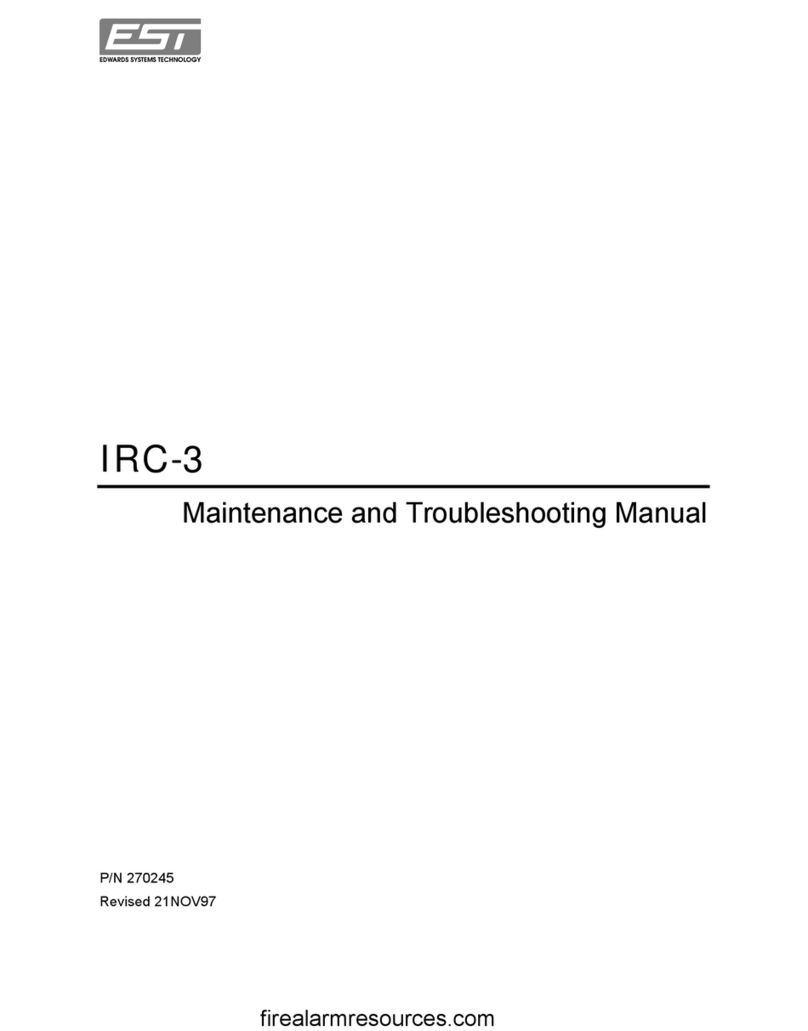
EDWARDS SYSTEMS TECHNOLOGY
EDWARDS SYSTEMS TECHNOLOGY IRC-3 Programming manual
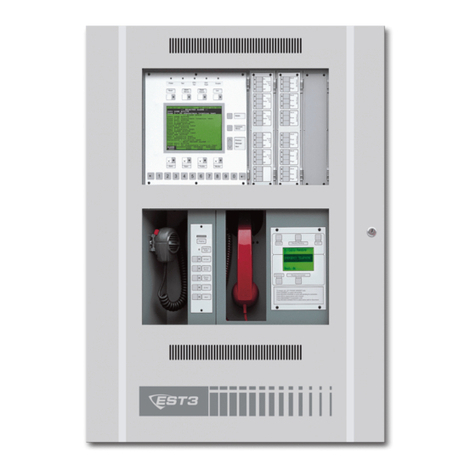
EDWARDS SYSTEMS TECHNOLOGY
EDWARDS SYSTEMS TECHNOLOGY EST3 User manual
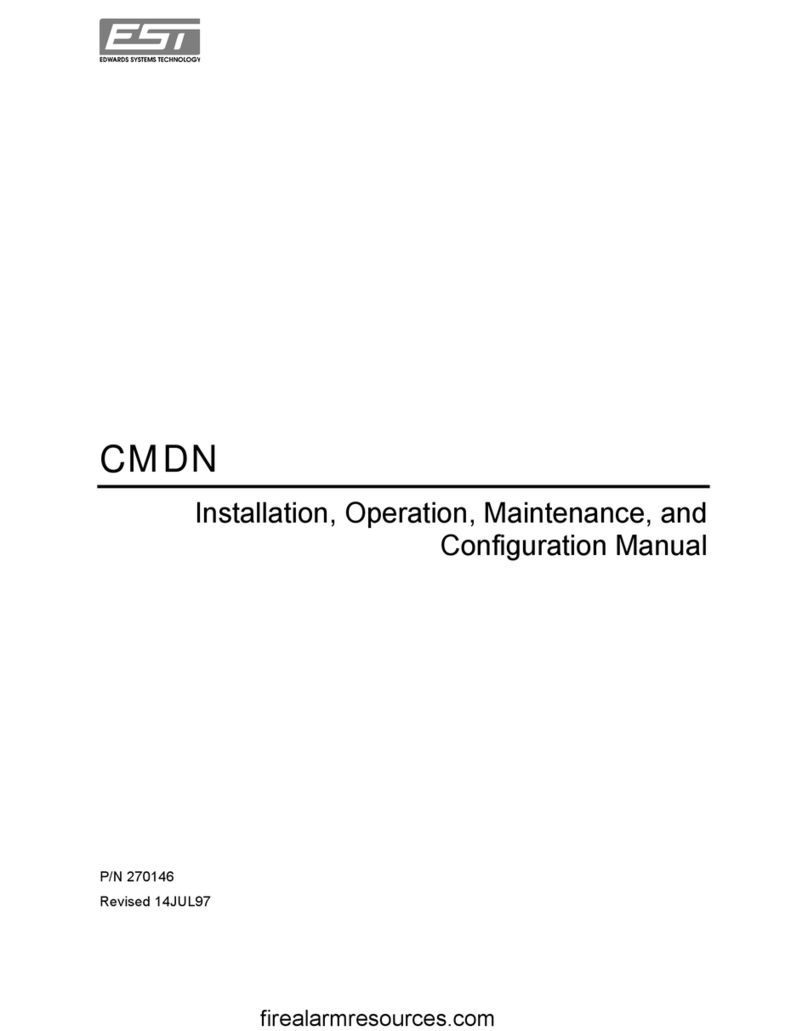
EDWARDS SYSTEMS TECHNOLOGY
EDWARDS SYSTEMS TECHNOLOGY CMDN Owner's manual

EDWARDS SYSTEMS TECHNOLOGY
EDWARDS SYSTEMS TECHNOLOGY EST3 User manual
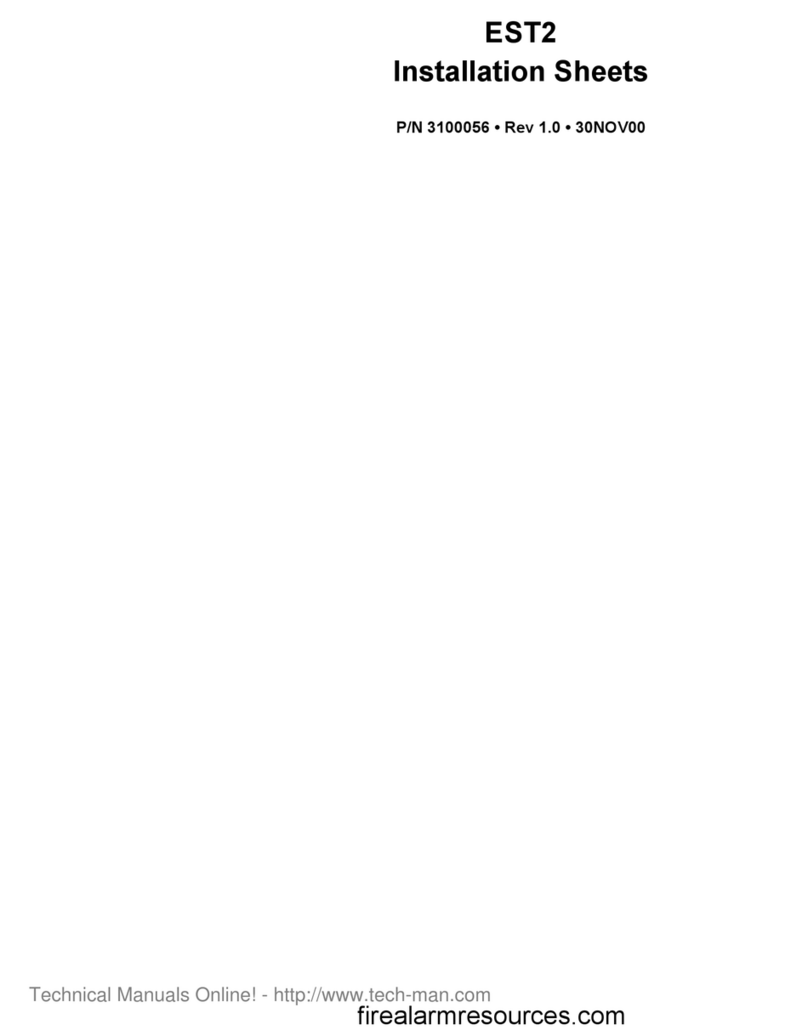
EDWARDS SYSTEMS TECHNOLOGY
EDWARDS SYSTEMS TECHNOLOGY EST2 User manual
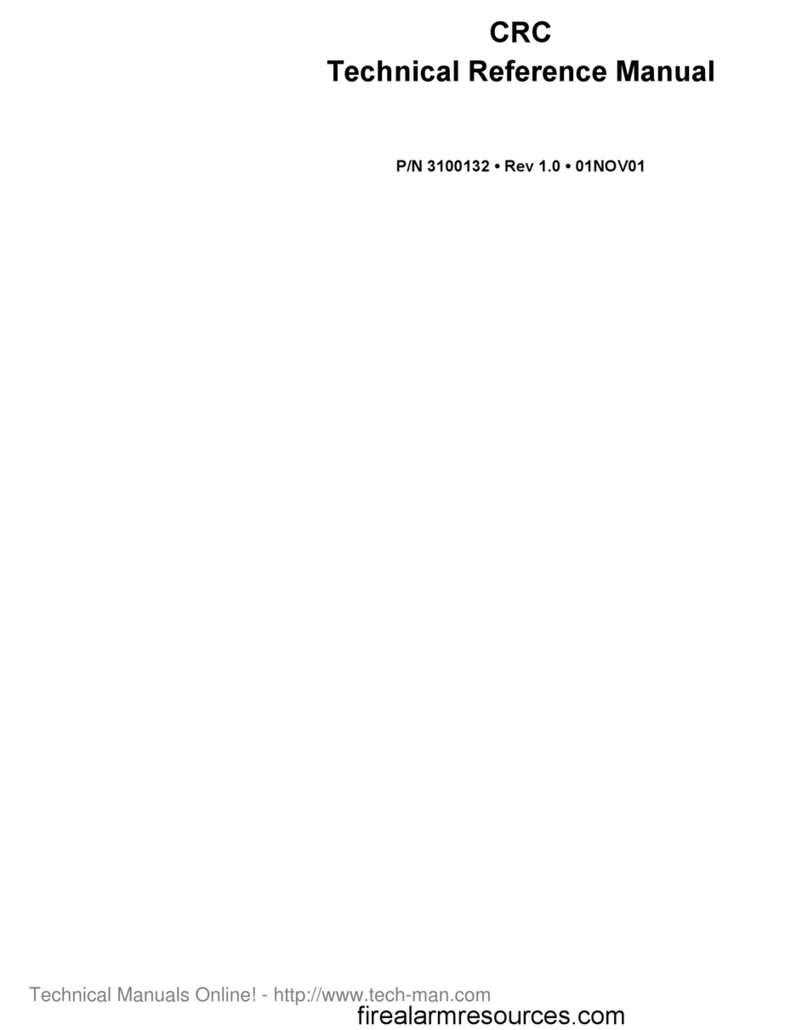
EDWARDS SYSTEMS TECHNOLOGY
EDWARDS SYSTEMS TECHNOLOGY CRC Product manual

EDWARDS SYSTEMS TECHNOLOGY
EDWARDS SYSTEMS TECHNOLOGY IRC-3 User manual
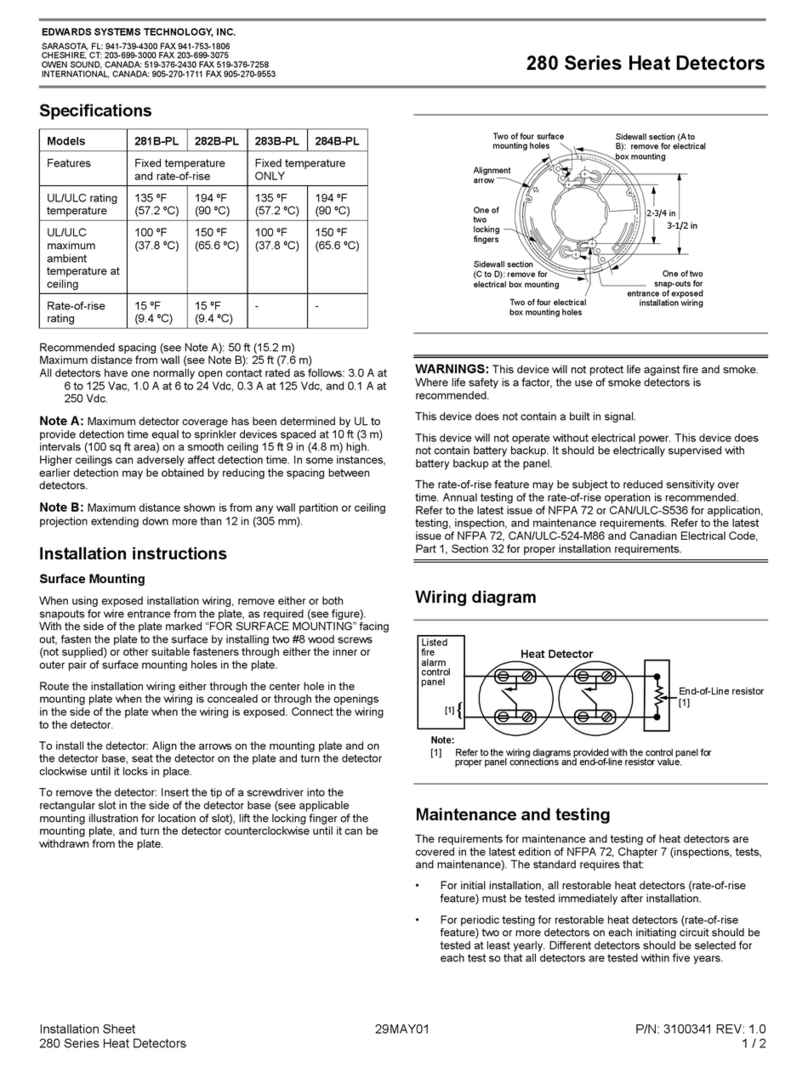
EDWARDS SYSTEMS TECHNOLOGY
EDWARDS SYSTEMS TECHNOLOGY 280 Series Assembly instructions

EDWARDS SYSTEMS TECHNOLOGY
EDWARDS SYSTEMS TECHNOLOGY EST3 User manual
